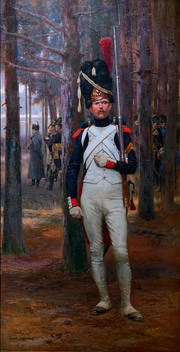Old Guard
| "La Vieille Garde" (The Old Guard) | |
|---|---|

Grenadier of the Old Guard wearing two veteran chevrons representing 15 to 20 years of service
|
|
| Active | 1804–1815 |
| Country | France |
| Branch | French Army |
| Type | Veterans |
| Role | Élite troops |
| Engagements |
Lodi |
| Commanders | |
| Notable commanders |
Dorsenne Bessières Davout Soult Cambronne |
Lodi
Austerlitz
Wagram
Dresden
Ligny
The Old Guard (French Vieille Garde) were the elite veteran elements of the Emperor Napoleon's Imperial Guard. As such it was the most prestigious formation in Napoleon's Grande Armée. French soldiers often referred to Napoleon's Imperial Guard as "the Immortals."
The Old Guard was formed of veteran soldiers who had served Napoleon since his earliest campaigns.
It is believed that Napoleon hand-selected members of his Old Guard based on physical traits, most notably above-average height. Their imposing stature was likely impressive to foes and allies alike. Serving in the army for several years as well as a citation for bravery were also taken into consideration when selecting troops into the Old Guard.
There were four regiments of Old Guard infantry: the 1st Grenadiers, 2nd Grenadiers, 1st Chasseurs, and 2nd Chasseurs. Members of the Old Guard benefitted from a number of different privileges. The wages of individual soldiers in the Old Guard were considerably higher than any other military unit in Napoleon's Imperial Guard.
In 1814 the 1st Chasseurs still had many old-timers: for example sapper Rothier with 21 years' service and two wounds; Private Stoll with 22 years' service and 20 campaigns. Those who were too old, or crippled, were sent to the Company of Veterans in Paris. This small unit was full of soldiers, some lacking an arm, others striped with saber cuts.
Each member of the Old Guard was a highly trained and experienced soldier and mustered into regiments; a formidable sight on any battlefield. Almost always above average height (1.85 metres (6 ft 1 in)) and being imposingly well-built, a member of the Old Guard was taught to fight unlike any other soldier in the French Army.
Any cowardly tendencies or otherwise cautious habits would be thoroughly purged through the help of longer and more intense training, often including advanced bayonet and hand-to-hand combat techniques. Yet the Old Guard earned its fearsome reputation through the many military engagements of the Napoleonic Wars, from the Battle of Austerlitz, to the Battle of Dresden, to the famous and final Battle of Waterloo (June 1815).
...
Wikipedia
